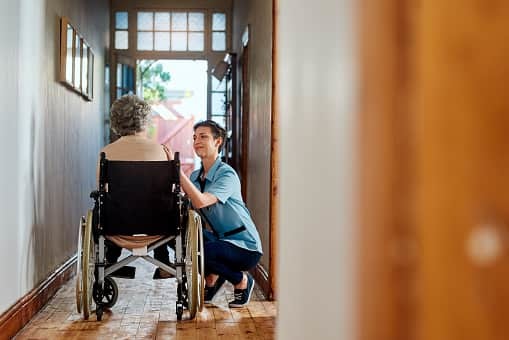How much does assisted living cost?
See average costs by state and how to pay

Assisted living helps older people maintain their independence while getting the aid they need. Unfortunately, it comes at a cost. The average nationwide cost to live at an assisted living facility is $4,300 per month, according to Genworth’s 2020 Cost of Care Survey. However, the amount you can expect to pay may differ, and your assisted living costs may not be as expensive as they initially seem.
In this article, we discuss how facilities determine their pricing, how costs differ by state and how people pay for this type of care.
Assisted living cost breakdown
Every assisted living facility charges differently, depending upon the services and amenities they offer. However, most assisted living facilities include the following in their costs:
- Room: This includes a place to live and any facility fees.
- Board: Facilities often provide three meals a day and snacks, but residents are generally free to eat on their own if they wish.
- Basic aid: One of the main benefits of assisted living is access to care staff. If necessary, these professionals can help you or your loved one with activities of daily living (ADLs), like bathing, eating and getting dressed.
- Activities: On-site activities are almost always included in the base cost of the facility. Certain activities, such as off-site outings or guest lecturers, may cost extra, though.
- Housekeeping and laundry: These services are less common than the above items, but they’re still available more often than not. If they aren’t included, they are usually offered for an additional fee.
As you’re comparing assisted living facilities, research and ask questions to see what’s included at each community. Before you or your loved one moves into an assisted living facility, you should also be given a contract that breaks down the services provided and exactly how much you will pay.
Factors that determine assisted living costs
While assisted living generally covers the above services and amenities, there are other factors that you may have to account for in your budget.
Generally speaking, the biggest factor you have to think about is medical care. Medical care may or may not be provided on-site at an assisted living facility, but either way, it’s an additional cost. The amount you pay will vary depending on your or your loved one’s insurance and the services provided. So, when calculating the cost of assisted living, also consider monthly premiums for health insurance, copays, prescription costs, medical equipment costs and the cost of doctors’ appointments.
Most assisted living facilities include room, board, activities and personal care in their baseline costs.
Other factors that also determine the cost of assisted living include:
- Location: Assisted living facility prices vary from state to state. Typically, Southern states have more affordable assisted living than Western and Northeastern states. We’ve broken down these differences below.
- Move-in fees: Some facilities charge a fee to move in. This fee covers administrative costs and helps complete any paperwork that needs to be done.
- Transportation: This is included in the cost of the facility — but not always. If a resident wishes to go shopping or needs to get to a doctor's appointment, they will have to factor in the cost of traveling either by public transportation or dial-a-ride services.
- Personal expenses: Residents are responsible for their own toiletries, clothing and personal items.
- Phone/cable/internet: These services may be offered as part of your monthly fee. However, they could also be available for an additional charge.
- Level of care: The more care a resident needs, the more expensive assisted living will be. Memory care, which requires intense supervision and care, is often an additional charge.
- Security: Staff is available to monitor your loved one. However, additional security and safety features, such as motion detectors or call pendants, may be available for an additional cost.
Remember, assisted living costs also vary from facility to facility. It is not uncommon to see a difference of thousands of dollars in monthly costs between assisted living facilities located in the same city.
Costs vary so dramatically for assisted living because there is such a wide variety of services, living options and levels of care. Each of these factors influences the cost of assisted living. A basic assisted living facility that provides meals, room and board, minimal supervision and assistance with daily tasks may only cost approximately $4,300 per month nationwide. However, luxury assisted living facilities can cost over $6,000 per month because they offer more services and amenities.
Average cost of assisted living by state
To give you a better understanding of how much assisted living costs vary nationwide, we’ve included the median monthly costs for a private, one-bedroom apartment at an assisted living facility in each state below. The following monthly costs are from Genworth’s Cost of Care Survey:
- Alabama - $3,150
- Alaska - $6,633
- Arizona - $3,900
- Arkansas - $3,500
- California - $5,000
- Colorado - $4,575
- Connecticut - $6,300
- Delaware - $6,690
- Florida - $3,700
- Georgia - $3,500
- Hawaii - $5,000
- Idaho - $3,675
- Illinois - $4,575
- Indiana - $4,382
- Iowa - $4,073
- Kansas - $5,090
- Kentucky - $3,699
- Louisiana - $3,639
- Maine - $5,942
- Maryland - $5,000
- Massachusetts - $6,085
- Michigan - $4,200
- Minnesota - $4,283
- Mississippi - $3,713
- Missouri - $3,000
- Montana - $4,213
- North Carolina - $3,800
- North Dakota - $4,096
- Nebraska - $4,188
- New Hampshire - $6,650
- New Jersey - $6,650
- New Mexico - $4,050
- Nevada - $3,595
- New York - $5,991
- Ohio - $4,350
- Oklahoma - $3,750
- Oregon - $4,659
- Pennsylvania - $3,955
- Rhode Island - $4,950
- South Carolina - $3,988
- South Dakota - $3,638
- Tennessee - $4,039
- Texas - $3,988
- Utah - $3,400
- Virginia - $4,850
- Vermont - $5,310
- Washington - $5,750
- Wisconsin - $4,400
- West Virginia - $4,000
- Wyoming - $4,175
How much does assisted living cost for a couple?
Most assisted living facilities allow couples, family or friends to share an apartment or room. If a residence is shared, there may be a slight additional charge for the extra person, but it usually isn’t double the cost, depending on the exact living situation. A couple sharing a room might only pay a fraction more than a single resident.
This is one reason it’s important to consider how a facility breaks down its costs. A couple sharing a room shouldn’t pay too much extra for their housing, but they will likely need to pay more for the additional services and amenities the spouse will use.
|
|
|
How to pay for assisted living
Assisted living may seem expensive, but there are a number of ways you can pay for it. While Social Security benefits are the most popular way to pay for assisted living, they generally won’t cover the entire cost. We’ve outlined some additional ways to pay for assisted living below.
- Long-term care insurance
- Long-term care insurance reimburses you for expenses related to personal or custodial care. However, advance planning is required with long-term care insurance, as you are required to pay a monthly premium in order to keep the policy active, and it’s much more affordable if you start at a younger age.
- Medicare
- Medicare does not cover the cost of personal care services, custodial care and room and board. Medicare provides some coverage for medical care that may be provided at assisted living facilities, though.
- Medicaid
- Some or all of the cost of assisted living may be covered by Medicaid, depending on the state you live in. However, Medicaid has very strict income and eligibility requirements. People may be required to sell their homes and other assets in order to qualify for Medicaid.
- Veterans benefits
- Veterans have access to senior communities run by the Department of Veterans Affairs. However, most of these communities are more focused on skilled nursing care rather than assisted living.
If you wish to live at an assisted living facility not run by the VA, you may be able to receive cash assistance from VA Aid and Attendance benefits.
- Bridge loans
- Bridge loans provide a fast way to secure financing if you need money for assisted living now. With a bridge loan, you are taking out a temporary loan that will generally be paid back once you sell a house or other asset. However, this type of financing is meant as a temporary solution and not meant to provide long-term funding.
- Annuity income
- Annuities are a long-term investment that provides you with a set monthly income. Unlike other financial investments, an annuity guarantees you a specific amount based on how much you invested. That amount will not change regardless of the state of the market or economy.
It takes careful planning and investing to use this type of financing for assisted living costs, though. You must invest for several years before you can collect on your annuity.
- Reverse mortgages
- Reverse mortgage borrowers generally receive a monthly payment in exchange for all or some of the equity in a home. However, reverse mortgages can be complicated, and one borrower must maintain the home as their primary residence or else the loan comes due. That means this option is generally only viable for couples where one partner lives at home and the other lives at an assisted living facility.
Health insurance rarely, if ever, covers the cost of assisted living. Sometimes, health insurance may cover the cost of any medical care you receive at an assisted living facility. However, it depends upon the policy and how the facility bills for such services. If the services are billed as part of the overall rate, health insurance will usually not cover them. If they're billed separately or by the individual vendor, health insurance may pay for them, though.
Bottom line
Assisted living isn’t cheap, but it’s much more affordable than some alternatives. Before you can determine how much assisted living is going to cost you, you'll want to think about what type of support and assistance you or your loved one needs. You can then research facilities to find one that fits your budget and provides the right level of care.
- Article sources
- ConsumerAffairs writers primarily rely on government data, industry experts and original research from other reputable publications to inform their work. Specific sources for this article include:
- Genworth Financial, “Cost of Care Survey.” Accessed May 5, 2021.



